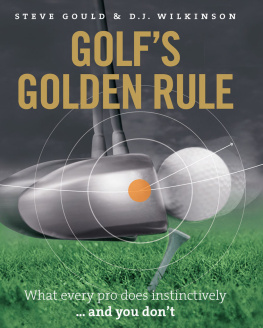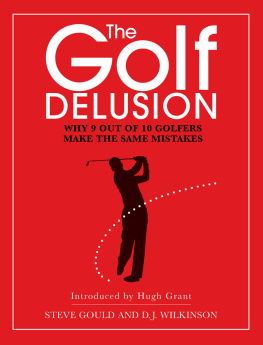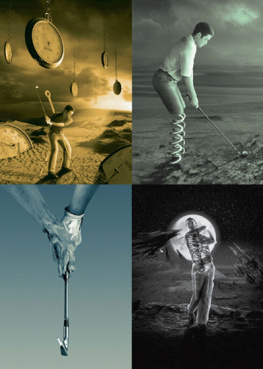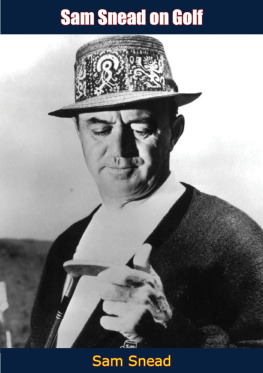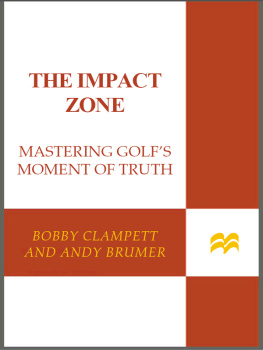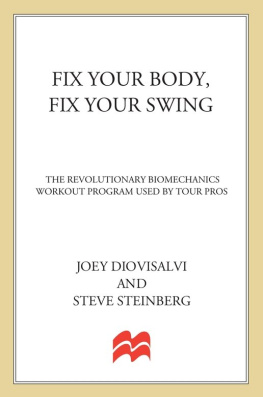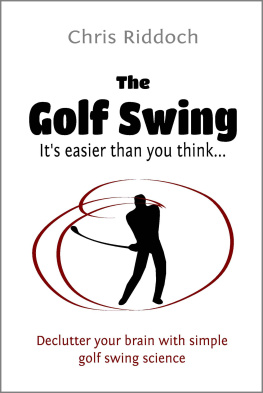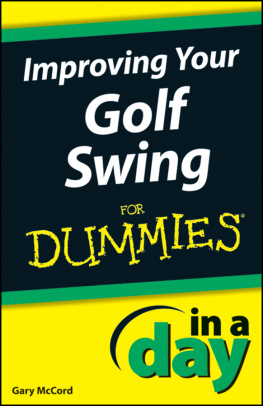FINISHING
SCHOOL
Contents
We would like to thank:
Pippa Crane, Lorne Forsyth, Mark Barton, Philip Talbot, Dave Lamplough, Chris Dale, Charles Briscoe-Knight, Tony Lawrence, Grant Richens, Henry Mendus, Robin Vaughan, Jon Wainwright and Alison Menzies.
Foreword
I had already won two US Amateur Championships when, in 1981, my husband and teacher Brian first took me to London to see Leslie King. Brian wanted him to look at my swing and see what steps should be taken to lift my game to the next level.
I was fascinated when the old master started honing my swing by primarily working on my finish. In particular he made me pay attention to the arc of the hands and arms through the post-impact position.
I spent most of my time practising his trademark Front End Therapy drill. Once happy with that, he then sculpted the rest of my swing into the finish, while making allowances for my individual swing mannerisms.
When we returned home Brian continued to work to Mr Kings guidelines and I went on to win a further Amateur Championship. Then, as a professional, I won two US Opens and was later honoured to be elected to the World Golf Hall of Fame.
Looking at the swings of todays pros, on both the mens and ladies tours, Im amazed at how technically identical they are to the technique pioneered by Leslie King back in the late 1930s.
Im pleased to see that the Knightsbridge Golf School is more successful than ever and that Dave and Steve have continued to develop and evolve Mr Kings original teachings. I believe that Finishing School will prove to be a great help to all struggling golfers who have never realised how crucial building a sound post-impact arc is to building a consistent, repeatable golf swing.
Juli Inkster, seven-time Major championship winner


Introduction
Introduction
Over the last sixty-five years, the Knightsbridge Golf School has witnessed tens of thousands of golf swings, their owners ranging from the rawest of beginners to the most experienced of tour professionals.
During that time, golf instruction has developed from a few tips here and there into a hugely detailed industry, incorporating swing gurus, mental coaches, fitness programmes and much, much more.
It is fair to say that the set-up, backswing and downswing have now been well documented and in most cases well understood, to the point that the swing fundamentals of todays golfers are far superior to those of their predecessors.
What hasnt changed and what has barely merited any focused attention is what happens a nanosecond before impact, continuing through impact and into the follow-through. The finish, indeed, is widely regarded as an afterthought.
Yet it is vital to realise that what happens just after impact begins just before it, and so is crucial in determining the direction, distance and destination of the ball.
What so frustrates golfers is that they can hit five or six good shots in a row, followed by five or six bad ones, without perceptibly changing their swing. They dont know why this happens, or how to rectify it. They just know that this wretched sequence keeps repeating itself throughout their golfing lifetime. They are trapped in a perpetual, vicious circle.
Desperate for a solution, most trawl the Internet, study videos, take tips from golf magazines, tinker with their backswings or reroute their downswings. Sadly, nothing seems to make a difference. Why? It is simply because they are looking in the wrong place.
In the vast majority of cases the problem has nothing to do with their set-up, backswing or downswing. It begins a split second before impact and reveals itself after impact and into the follow-through.
What these players should be doing is looking towards the finish, in order to help them sculpt a post-impact arc that is symmetrical to their pre-impact arc. The arc, after the ball has been struck, must be a carbon copy of what went before.
Once this has been established, the backswing and downswing can be blended into a consistent, defined, seamless and complete arc.
Like every other golf book, this one is designed to improve your game. More than that, though, we think it will completely change the way you think about the golf swing.
We want you to take a fresh look, and from a different angle. In effect, we want to teach you back-to-front. We want you to start at the finish.
We begin by looking at what we mean by keeping the arc symmetrical, and how that can be achieved. Once we understand the arc, we can move onto our programme for immediate improvement we call it Front End Therapy and highlight the finish by looking at it from overhead. To many golfers, these pictures could provide a light-bulb moment.
We then work backwards. We show how to deliver the club head powerfully and squarely into the ball, before returning to where we started and re-emphasising how the clubs arc should be maintained through impact and into the finish.
Youll find in this book that we rely on pictures more than words to explain our technique. Experience has taught us that golfers learn far more from studying large, clearly labelled pictures than reading swathes of text. It may be a clich but it is no less true a picture really does paint a thousand words.
We also look at the same key points from a variety of angles. Again, we have found that repetition of the same instruction, seen from different angles and described using different terms, often gets through to a reader who may have missed the point in its original form.
We see this frequently at the school when looking in on each others lessons. Saying the same thing in a different way can produce that moment of enlightenment for our golfers. Why didnt you tell me that before? is frequently the response.
Youll also find that the information here is supported by additional video content that you can find online at our website, www.knightsbridgegolfschool.com .
The teachings contained within this book are not theoretical. They have been proven in tens of thousands of lessons over the past sixty-five years since the Knightsbridge Golf School was founded. We are convinced that, by learning to build a post-impact, structured arc, we can finally bring to an end the miserable cycle of trial-and-error golf that youve been grappling with for so long.


The pictures opposite show real swings in motion. The pictures are not of a high quality these are real golfers, not posed pictures but the problem in each should still be easy to spot.
These golfers possess a more than serviceable backswing and downswing. In the split second before impact, however, the body stalls and the arms and hands pull the club head away from its intended arc through the impact area.
It is this movement that betrays itself in the distorted, contorted shapes seen here at impact and in the half-finish positions.


